Abstract
OBJECTIVES. The purpose of this study was to determine how the method of assessment affects patient report of human immunodeficiency virus (HIV) risks. METHODS. Patients at a sexually transmitted disease clinic randomly received either a written self-administered questionnaire or an audio self-administered questionnaire delivered by cassette player and headset. These questionnaires were followed by face-to-face interviews. RESULTS. Audio questionnaires had fewer missing responses than written questionnaires. Audio questionnaires also identified more unprotected vaginal intercourse and sexual partners suspected or known to have HIV infection or acquired immunodeficiency syndrome than did written questionnaires. Although both the audio and written questionnaires identified more risks than the face-to-face interviews, the difference in the mean number of reported risks between the audio questionnaires and the face-to-face interviews was greater than that between the written questionnaires and the face-to-face interviews. CONCLUSIONS. Audio questionnaires may obtain more complete data and identify more HIV risk than written questionnaires. Research is warranted about whether audio questionnaires overcome barriers to the completion and accuracy of HIV risk surveys. This study emphasizes the need to elucidate the relative strengths and weaknesses of written questionnaires, audio questionnaires, and face-to-face interviews for HIV risk assessment.
Full text
PDF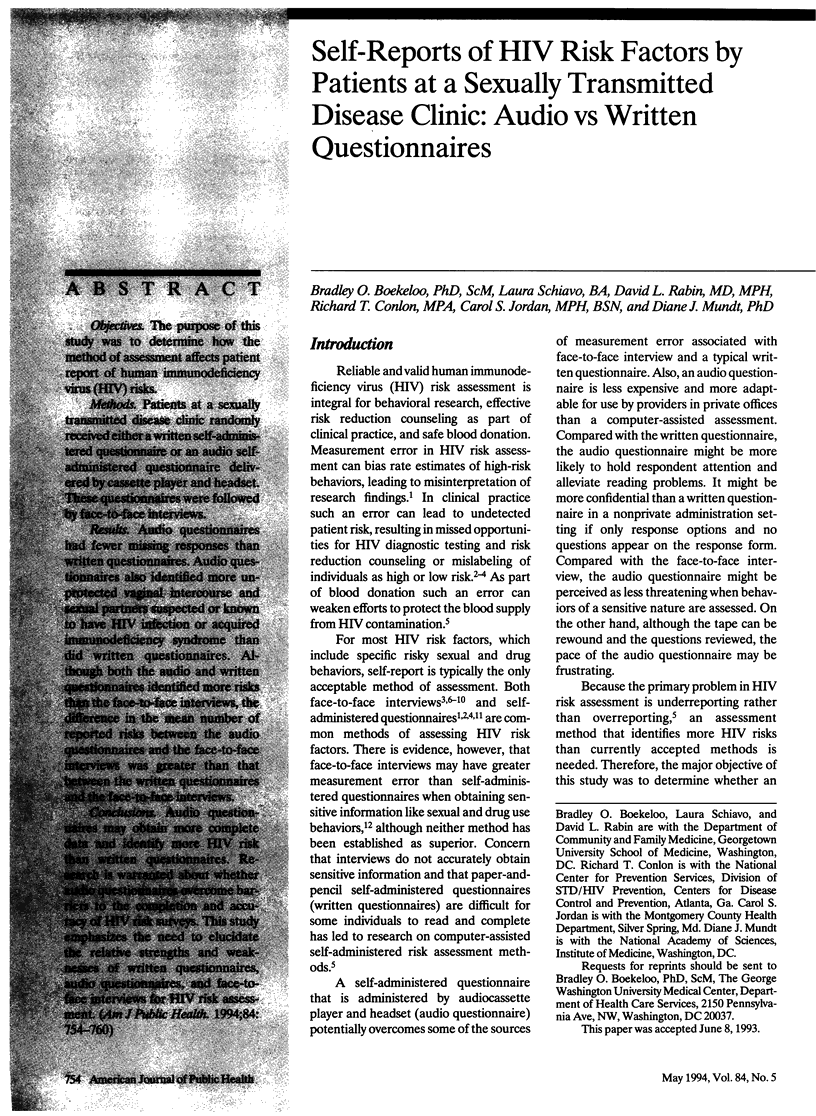
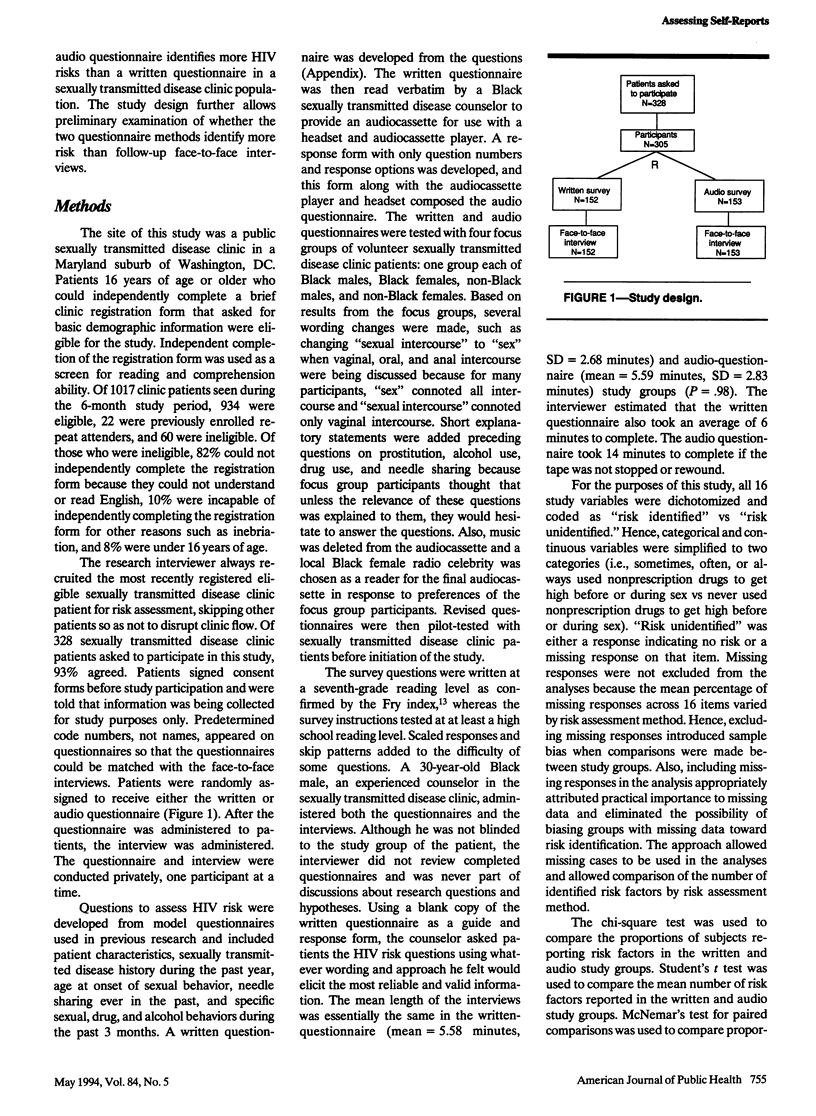
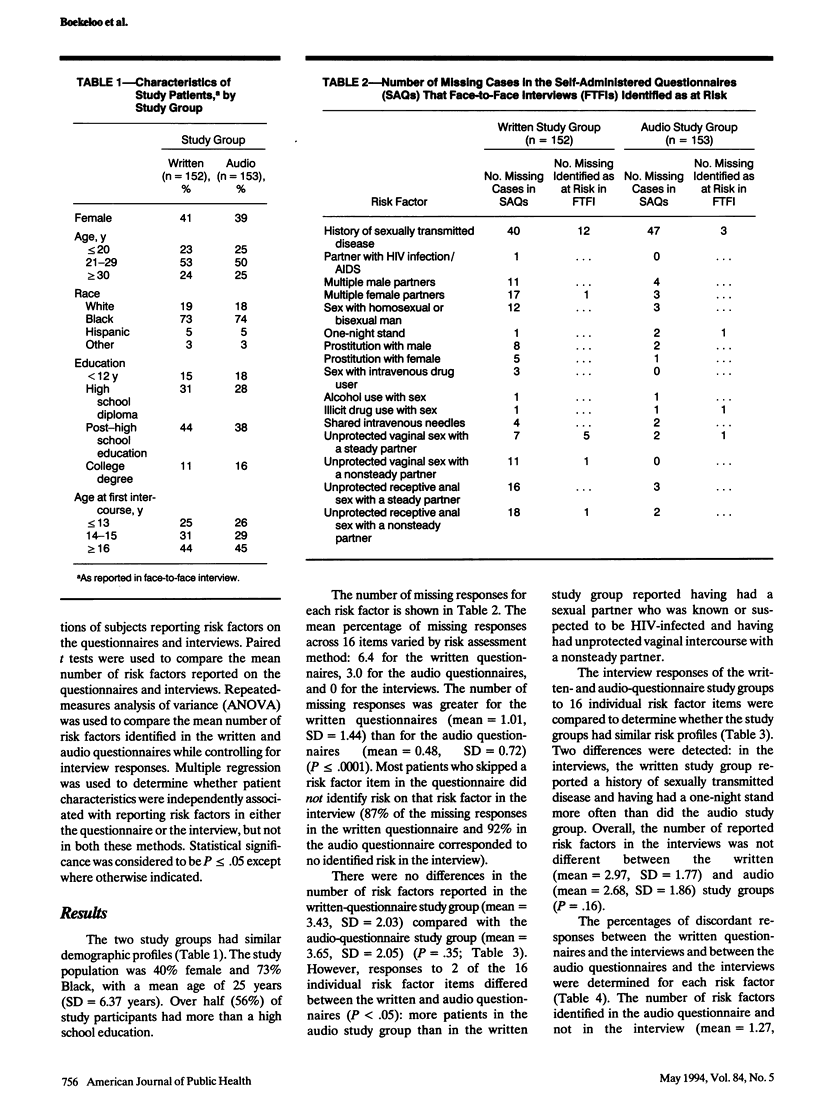
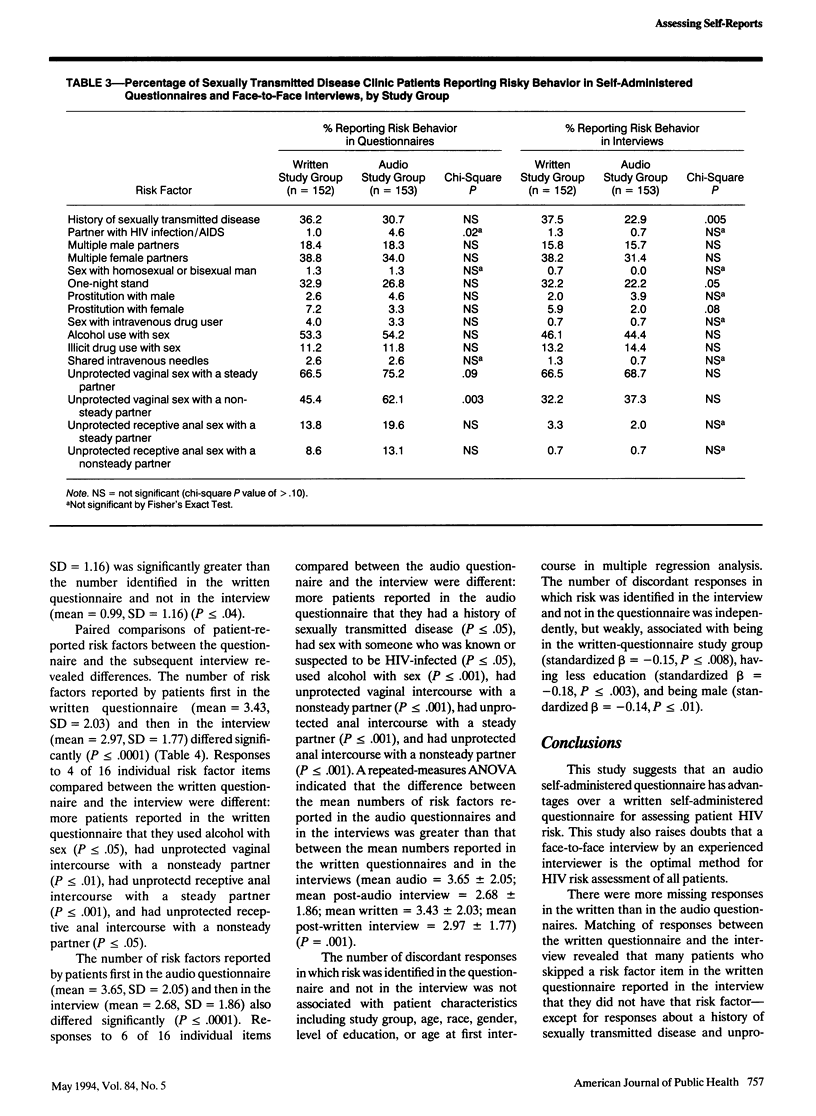

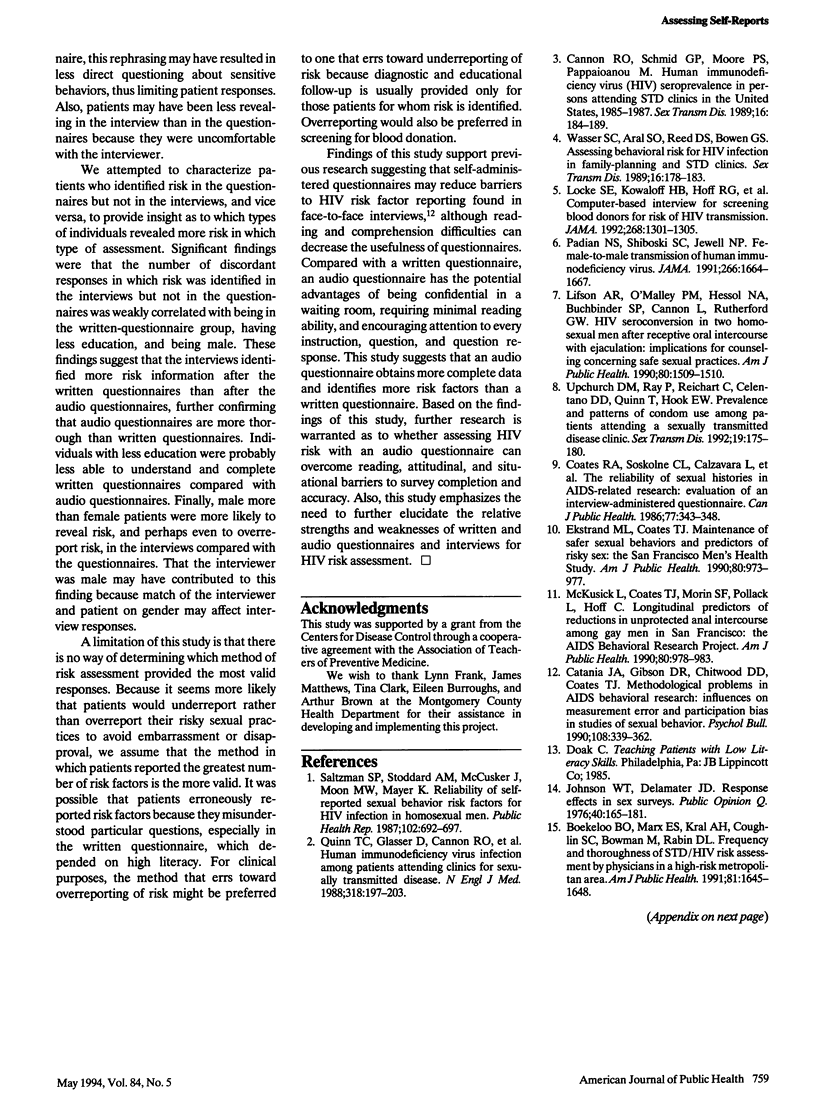

Selected References
These references are in PubMed. This may not be the complete list of references from this article.
- Boekeloo B. O., Marx E. S., Kral A. H., Coughlin S. C., Bowman M., Rabin D. L. Frequency and thoroughness of STD/HIV risk assessment by physicians in a high-risk metropolitan area. Am J Public Health. 1991 Dec;81(12):1645–1648. doi: 10.2105/ajph.81.12.1645. [DOI] [PMC free article] [PubMed] [Google Scholar]
- Cannon R. O., Schmid G. P., Moore P. S., Pappaioanou M. Human immunodeficiency virus (HIV) seroprevalence in persons attending STD clinics in the United States, 1985-1987. Sex Transm Dis. 1989 Oct-Dec;16(4):184–189. doi: 10.1097/00007435-198910000-00005. [DOI] [PubMed] [Google Scholar]
- Catania J. A., Gibson D. R., Chitwood D. D., Coates T. J. Methodological problems in AIDS behavioral research: influences on measurement error and participation bias in studies of sexual behavior. Psychol Bull. 1990 Nov;108(3):339–362. doi: 10.1037/0033-2909.108.3.339. [DOI] [PubMed] [Google Scholar]
- Coates R. A., Soskolne C. L., Calzavara L., Read S. E., Fanning M. M., Shepherd F. A., Klein M. M., Johnson J. K. The reliability of sexual histories in AIDS-related research: evaluation of an interview-administered questionnaire. Can J Public Health. 1986 Sep-Oct;77(5):343–348. [PubMed] [Google Scholar]
- Ekstrand M. L., Coates T. J. Maintenance of safer sexual behaviors and predictors of risky sex: the San Francisco Men's Health Study. Am J Public Health. 1990 Aug;80(8):973–977. doi: 10.2105/ajph.80.8.973. [DOI] [PMC free article] [PubMed] [Google Scholar]
- Lifson A. R., O'Malley P. M., Hessol N. A., Buchbinder S. P., Cannon L., Rutherford G. W. HIV seroconversion in two homosexual men after receptive oral intercourse with ejaculation: implications for counseling concerning safe sexual practices. Am J Public Health. 1990 Dec;80(12):1509–1511. doi: 10.2105/ajph.80.12.1509. [DOI] [PMC free article] [PubMed] [Google Scholar]
- Locke S. E., Kowaloff H. B., Hoff R. G., Safran C., Popovsky M. A., Cotton D. J., Finkelstein D. M., Page P. L., Slack W. V. Computer-based interview for screening blood donors for risk of HIV transmission. JAMA. 1992 Sep 9;268(10):1301–1305. [PubMed] [Google Scholar]
- McKusick L., Coates T. J., Morin S. F., Pollack L., Hoff C. Longitudinal predictors of reductions in unprotected anal intercourse among gay men in San Francisco: the AIDS Behavioral Research Project. Am J Public Health. 1990 Aug;80(8):978–983. doi: 10.2105/ajph.80.8.978. [DOI] [PMC free article] [PubMed] [Google Scholar]
- Padian N. S., Shiboski S. C., Jewell N. P. Female-to-male transmission of human immunodeficiency virus. JAMA. 1991 Sep 25;266(12):1664–1667. [PubMed] [Google Scholar]
- Quinn T. C., Glasser D., Cannon R. O., Matuszak D. L., Dunning R. W., Kline R. L., Campbell C. H., Israel E., Fauci A. S., Hook E. W., 3rd Human immunodeficiency virus infection among patients attending clinics for sexually transmitted diseases. N Engl J Med. 1988 Jan 28;318(4):197–203. doi: 10.1056/NEJM198801283180401. [DOI] [PubMed] [Google Scholar]
- Saltzman S. P., Stoddard A. M., McCusker J., Moon M. W., Mayer K. H. Reliability of self-reported sexual behavior risk factors for HIV infection in homosexual men. Public Health Rep. 1987 Nov-Dec;102(6):692–697. [PMC free article] [PubMed] [Google Scholar]
- Upchurch D. M., Ray P., Reichart C., Celentano D. D., Quinn T., Hook E. W., 3rd Prevalence and patterns of condom use among patients attending a sexually transmitted disease clinic. Sex Transm Dis. 1992 May-Jun;19(3):175–180. [PubMed] [Google Scholar]
- Wasser S. C., Aral S. O., Reed D. S., Bowen G. S. Assessing behavioral risk for HIV infection in family-planning and STD clinics: similarities and differences. Sex Transm Dis. 1989 Oct-Dec;16(4):178–183. doi: 10.1097/00007435-198910000-00004. [DOI] [PubMed] [Google Scholar]


